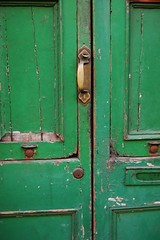I’m a glutton for a good story. My favorite kind of story is the one that just appears – inline – walking with a friend from one place to the next; waiting for something, anything; sharing a drink; hanging out on the back patio.
When you tell me a story you tell me not just what happened, but what mattered to you when it all came about. And knowing what matters to you helps me understand the way you see the world you live in. And when it’s a good story, it makes me realize that you and I are not so different, friend. Which makes the world a little bit easier to live in.
This is one of those inline stories: doctorbob@flickr posted a shot of a lyrical green door in Dublin – he called it “The Musical Door” (which is just as good as calling out “Krick?”) I bit – others did too – my comment: “why so musical? does it squeak?” (Krack!). And he replied to the lot of us:
@david - thanks for your support :)
@jinmo - love your individuality in your images.
@suttonhoo, are you sitting comfortably?
@jennifer - then, let us begin:
This is the door to an old musical instrument shop in Dublin on one of my favourite streets, Capel Street.
Capel Street is a long Georgian street dating from the last years of the 17th century, the buildings of which have mostly 18th century facades, punctuated here and there by a Victorian pub or a modern office. Nothing is particularly out of place and nothing particularly changed from 250 years ago with the one exception that the street has taken a decidely downmarket air.
In the 18th century it was a fashionable parade with Dukes and Baronesses strolling along and purchasing lottery tickets - wealth was a given and the people inhabiting the street led lives unimaginable to the 'mere Irish' as they were known.
Along this street gentlemen in tailcoats pranced, ladies in plumed hats nodded and servants dashed at their masters whims. Meanwhile 5 miles in any direction from this spot people lived in apalling poverty and suffered some 8 famines in the lead up to the great one of 1845 when one million people died of starvation.
During the passage of the centuries this brilliant avenue began to drift from the raffishness of the lotteries, to gambling clubs and side street inns, gradually a middling crowd took over and the great pubs such as Slatterys appeared and provided a convivial pleasure for real working class Dubliners.
In between grocers, tailors and other merchants plied their wears only really losing ground as the suburbs spread outwards dragging with them the better class of customer in the early 20th century. The revolution, the resultant destruction of the city by British gunships and the catastrophe of the Civil War all played out within an asses roar of the street and pushed the wealth of the area further downwards.
In the 1930s the street was famous for habberdasheries and builders providers as well as furniture. The Emergency as the Second World War is known in Ireland killed off another layer of the small businesses and the street saw the beginnings of some new out of character buildings as planning and design were luxuries that Ireland could ill afford as emmigration sapped the life blood of the nation.
By the 70s the street was reduced to a busy stream of cheap furniture shops, one famous garden shop, an equally famous tailor and some less than salubrious pubs all snarled up in the beginnings of the angry love affair between Hibernia and the car.
Come the 80s stripped pine showrooms with myriad bunkbeds designed to house the baby boom of the early 70s became a common sight and then in the 80s and 90s something mad happened. Sex came to Ireland! Sex shops appeared, protests began, the church ranted, little old ladies railed, rosaries were proffered and yet the sex shops survived - albeit dyslexically - Uthopia (and perhaps they are).
But through it all from the 1920s onwards this little shop sold musical instruments. Fiddles to be loved and played and the soul of the street resided in that brass handle as musicians decades by decade came to view and buy lutes, guitars and all manner of melody makers.
The shop is closed now. That’s why I took the picture.
Photo credit, story credit, and full points to doctorbob.







No comments:
Post a Comment